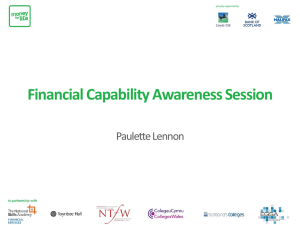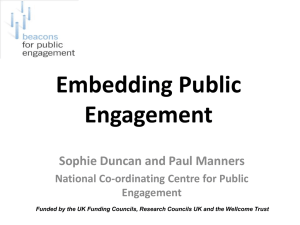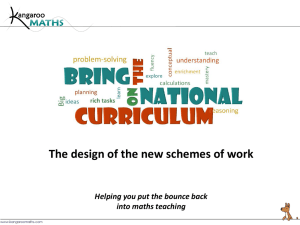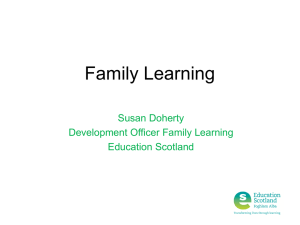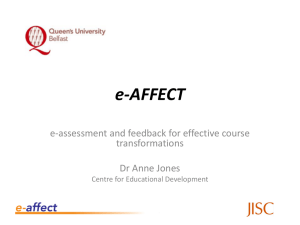Embedding Learning - City & Guilds Centre for Skills Development
advertisement
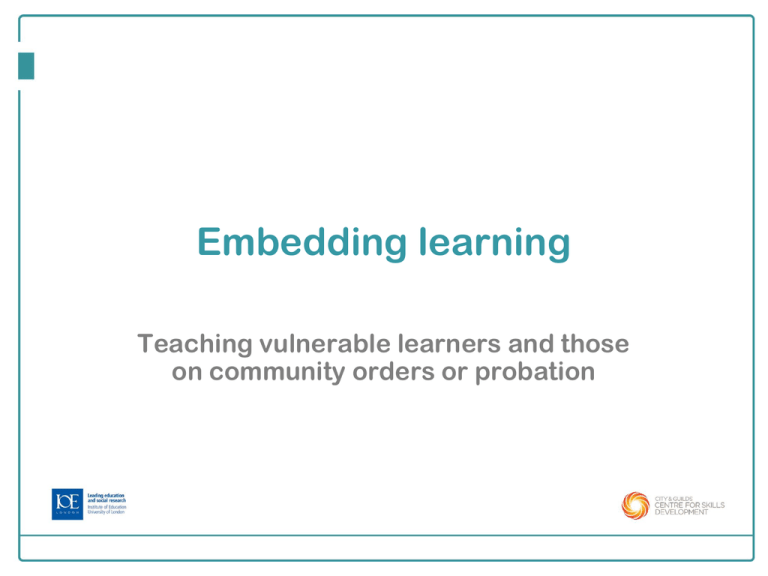
Embedding learning Teaching vulnerable learners and those on community orders or probation Embedding Learning: starter activity • Why embed learning? • What learning needs to be embedded? • What is embedded learning? • How can teachers embed learning successfully? Embedding learning 2 Why embed learning? Learners prefer learning to be embedded (Martinez, 2002; Roberts et al, 2005) They are • more motivated • find learning easier in a work or practical context • feel more confident/less stigmatised Embedding learning 3 What needs to be embedded? • • • • Literacy and language Everyday mathematics Everyday ICT Study skills to support on-going learning These are sometimes called the ‘Minimum Core’: all learning and skills sector teachers are now formally responsible for supporting minimum core learning Embedding learning 4 What is embedded learning? Vocational / life skills and knowledge Embedding learning Embedded learning and teaching Literacy, language, maths, ICT, and study skills 5 What is embedded learning? ‘Embedded teaching and learning combines the development of literacy, language and numeracy with vocational and other skills. The skills acquired provide learners with the confidence, competence and motivation necessary for them to succeed in qualifications, in life and in work.’ A Contextual Guide to Support Success in LLN Provision: Embedded Learning. DfES (QIA 2008) Embedding learning 6 There are three ways to support embedded learning 1. 2. 3. Embedding literacy/language, everyday maths and/or ICT in teaching and learning of the main subject Developing your students’ study skills Using feedback to support embedded learning Embedding learning 7 Planning to embed literacy, language, everyday maths and ICT • You do not have to be expert to support students’ embedded learning • Think about your main curriculum: what elements of the minimum core does it naturally contain? • Another way of thinking about this: What minimum core skills do your students need to learn their main curriculum effectively? • Remember to build on your students’ existing skills as far as possible Embedding learning 8 Embedding learning in Life and Employability skills Minimum core skills might include: • Confident and clear speaking and listening • Functional reading skills • Functional writing skills • Functional maths • Functional ICT • Study skills: planning, organisation, and timekeeping The appropriate balance of these will be different for each student, depending on their existing skills and their learning goals Embedding learning 9 Planning for embedded learning There are three approaches you could use: 1. Teaching some minimum core skills directly: adding specific elements of the minimum core into your lesson plans, separately from your main curriculum 2. Teaching some of these skills at the same time as your main curriculum 3. Focussing on these skills as part of feedback on classroom tasks and activities Embedding learning 10 Classroom activities for embedding learning • Projects, individual or collaborative • Discussions • Problem solving • Planning activities • Budgeting • Modelling • Games • Case studies • Debating Embedding learning • • • • • • • • • • Quizzes Evaluations Designing Imagining Comparing Demonstrations Practical experiments Research tasks Note-taking, diary writing Other? 11 Starter Activities You can use starter activities in a number of ways: • To provide productive activity for students who arrive early or on-time • To start the lesson in a lively way that will motivate students • To give a flavour of what is to come later in the lesson • To model productive learning behaviour right from the start Embedding learning 12 Suggested Starter Activities • Learners work in pairs list the ways that teaching involves either Maths, English or ICT skills • Learners discuss a question in groups of 5 or 6: eg ‘what level of qualification is necessary to work as a teacher?’ • Learners make group contributions to a blog or wiki page via mobile phones, laptops, or in writing • Learners swap homework assignments, and proof-read them for spelling mistakes, grammatical errors and typos • Learners organise their notes and hand-outs in a folder Embedding learning 13 1. Literacy and language • An effective way to support literacy and language learning is by giving constructive feedback on any writing tasks your students do as part of their learning • One way of approaching this is to think about their writing at word, sentence, or text level • In your feedback you focus on one or other of these levels at a time, so as not to confuse the learner. Aspects of literacy and language relating to each level are given on the next slide • For more on literacy, please refer to the Literacy CPD session Embedding learning 14 Level Writing Word Handwriting Sentence Word order Text Embedding learning Reading Speaking and listening Presentation skills 15 Level Writing Reading Word Handwriting Spelling Phonics Pronunciation Word recognition Vocabulary Word comprehension Sentence Word order Punctuation Use of tenses Understanding tenses Getting meaning from context Text Text comprehension Picking up detail Skimming Scanning Paragraphing Register Use of connectives Ordering information Understanding relevance Embedding learning Speaking and listening Presentation skills Intonation Use of vocabulary Body language 16 Reflecting on literacy • How can we improve our learners’… – – – – – – vocabularies? spelling of key terms? punctuation? grammar (sentence level writing)? reading confidence? confidence producing written assignments (planning, drafting, paragraphing, lay-out, proofreading, editing)? – confidence in speaking clearly? • You will find some ideas on the next slides Embedding learning 17 …vocabularies 1. 2. 3. 4. 5. 6. Encourage (or require) students to keep A-to-Z vocabulary note books of key terms and definitions Have regular quizzes (oral or written, teacher or student led) of the meaning of key terms Get students to make posters of key terms and their definitions and post these around the classroom Encourage students to read as much as possible and to report back and recommend books Have a weekly or fortnightly slot where students quiz each other on new words they have found Widen your own use of vocabulary in your teaching and resources Embedding learning 18 …spelling of key terms 1. Encourage or require students to keep spelling books where they record and practice the spelling of key terms (and have quizzes/create games to practice these) 2. Have regular (if short) spelling strategies sessions where develop students’ repertoire of strategies 3. Display these key terms around the classroom, getting students to make the displays if possible Embedding learning 19 …punctuation 1. Make/get posters about the use of each punctuation mark and display 2. Circle/code these as punctuation errors, but get learners to correct themselves- or peer correct 3. Look at students’ work and use punctuation difficulties as the basis for group punctuation workshops Embedding learning 20 …grammar (sentence level writing) 1. Teach the term ‘Standard English’ and the potential differences between Standard English and other dialects of English 2. Circle /code grammar errors, but get learners to correct themselves- or peer correct 3. Look at students’ work and use Standard English grammar difficulties as the basis for group workshops Embedding learning 21 …speaking and listening 1. Realistic role plays: job interviews, making a complaint to a bank, call centre work 2. Imaginative role plays: media interviews with people in the news, celebrities, etc 3. Debates: get students to choose topics 4. Drama: plays and poetry reading – build in performance evaluation by students Embedding learning 22 Activity: literacy and language • See Activity sheet, small group discussions on literacy and language • Note, there are similar discussions on maths, ICT and Study Skills suggested below • Select what is most important to your group and you can fit in to the available time for this session. If necessary, plan this for future discussions Embedding learning 23 2. Everyday maths • Planning practical activities, eg timetables, fares, currency, baggage weight, shopping, bargain offers, comparing prices • Budgeting, eg rent, gas, electricity, water, council tax, Christmas • Wages and PAYE • Sports statistics, league tables • Statistics and numbers eg in the news Embedding learning • Measurements, proportions, enlargement, symmetry • Angles, directions, orientation, maps • Scale and ratios • Using estimates • Timelines – history • Averages and percentages 24 Everyday maths examples • Choose topics relevant to students, that they have reported as giving them difficulties. These could be: – Estimating: eg amount of wood needed to make a cupboard – Scaling: doubling the quantities in recipes – Discounts and price comparisons: how much do you really save? – Sharing out café or restaurant bills – Calculating calories – Betting odds: how much will you win or lose? Embedding learning 25 Activity: everyday maths • See Activity sheet, small group discussions on everyday maths Embedding learning 26 3. Everyday ICT • Searching the web • Storing and accessing favourite sites • Using DVDs and CDs • Using BBC iplayer • Using Youtube • Using Facebook • Using Twitter • Word-processing • Sending emails • Reading and writing blogs • Using smartphones Embedding learning • Attaching files to emails • Inserting pictures and video clips into documents • Organising contacts in Outlook • Using Skype Organise classroom discussions about which of these are most important and the most useful Build on existing skills 27 Activity 3 • See Activity sheet for small group discussions on everyday ICT Embedding learning 28 4. Study skills • • • • Reading and using written materials Producing written assignments Note-taking (from classes or from writing) Folder/work organisation How can we develop these study skills? Embedding learning 29 Activity 4 • See Activity sheet, small group discussions on study skills Embedding learning 30 Reading and using written materials 1. Get students to think as widely as possible about what reading is or involves, perhaps making posters 2. Encourage students to identify own strengths and areas for development; create personal action plans to address these 3. Teach and review the terms skimming, scanning, close reading, summarising and note-taking and practice these using subject specific materials Embedding learning 31 Producing written assignments 1. Be explicit about the requirements of each written assignment 2. Explore or teach steps to producing a piece of written work, emphasising that drafting, outlining, proofreading are important 3. Encourage writing ‘buddies’ or other forms of collaborative pairings for peer support 4. Look at examples of successful pieces of writing and explore what makes these successful Embedding learning 32 Note-taking 1. Teach examples of different styles of note-taking (sentences, key words, diagrammatical...) 2. Give examples of notes taken and ask students to evaluate the strengths and challenges of each 3. Encourage students to experiment with different coloured pens, pencils, highlighters and ICT to ‘repackage’ their notes Embedding learning 33 Folder or work organisation 1. Show examples/models of organised folders 2. Give direct instruction of how to organise work 3. Discuss folder/work organisation in tutorials Embedding learning 34 Activity 5 • Feedback activity – see Activity sheet. You will need to prepare for this before the session by bringing in some of your students’ work. Embedding learning 35 Guidelines for effective written feedback Be selective: prioritise, don’t highlight everything Be specific: make precise points using examples Include both strengths and areas for development Think about word, sentence and text levels Using a marking code if appropriate Be developmental: link to future work Embedding learning 36 Activity 6 • Please refer to Activity 6 – planning a teaching session • Alternatively, this could be a follow-on activity in your next CPD session Embedding learning 37 Activity 7: Evaluation & Plenary – rounding up the session • Please note the three most important points you have learned from this session, and how it will make a difference to your teaching in the future • Identify and share specific areas of your own skills and knowledge that you want to develop, in relation to embedding the minimum core in your teaching Embedding learning 38 Materials in this CPD were devised by the following members of the Institute of Education: Brian Creese (numeracy), Jay Derrick (assessment and embedding), Jane Hurry (motivation and exit strategies), Maria Kambouri (ICT), Irene Schwab (literacy) and John Vorhaus (continuing professional development and learner contexts) Helpful suggestions and comments were made by Joe Shamash and Olivia Varley-Winter at City & Guilds Centre for Skills Development. If you would like to contact us please email Jane Hurry at j.hurry@ioe.ac.uk Embedding learning 39 The CPD Framework An outline of the sessions Embedding learning 40
